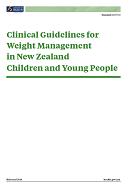Published online:
16 December 2016

This publication provides updated clinical guidance for primary health care practitioners and others who provide advice on weight management for New Zealand children and young people aged 2 to 18 years.
The Guidelines follow a four-stage process: monitor, assess, manage, and maintain. The key components of management are FAB: Food and drink, Activity (including reducing sedentary time, and supporting sufficient sleep), and Behavioural strategies.
There are three new additions or changes:
- Regular monitoring of height, weight and BMI is recommended for all children and young people to enable early identification and advice for those who are trending towards obesity.
- To align with the New Zealand-World Health Organization (NZ-WHO) growth chart for two to five year olds, the Guidelines include the recommendation to use a new NZ-WHO growth chart for 5–18 year olds (currently being developed). Both charts define overweight as over the 91st centile, and obesity as over the 98th centile.
- Recognition of the role that sufficient sleep plays in weight management for children and young people, along with recommended hours of sleep by age.
